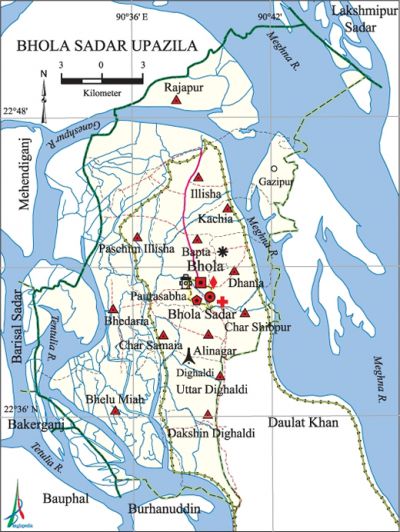Bhola Sadar Upazila
Bhola Sadar Upazila (bhola district) area 413.16 sq km, located in between 22°32' and 22°52' north latitudes and in between 90°32' and 90°44' east longitudes. It is bounded by mehendiganj and lakshmipur Sadar upazilas on the north, bauphal and burhanuddin upazilas on the south, daulatkhan upazila on the east, barisal sadar, Mehendiganj and bakerganj upazilas on the west. Population Total 408094; male 210820, female 197274; Muslim 394553, Hindu 13413, Buddhist 47, Christian 19 and others 62. Water bodies Main rivers: meghna, tentulia.
Administration Bhola Upazila was formed in 1842 and it was turned into an upazila on 1 February, 1984.
| Upazila | ||||||||
| Municipality | Union | Mouza | Village | Population | Density (per sq km) | Literacy rate (%) | ||
| Urban | Rural | Urban | Rural | |||||
|
1 |
13 |
98 |
122 |
74990 |
333104 |
988 |
60.7 |
33.8 |
| Municipality | ||||||||
|
Area
|
Ward
|
Mahalla
|
Population
|
Density
|
Literacy rate (%)
| |||
|
22.66
|
9
|
18
|
40479
|
1786
|
72.14 | |||
| Upazila Town | ||||||||
|
Area
|
Mouza
|
Population
|
Density (per sq km
|
Literacy rate (%)
| ||||
|
9.27
|
6
|
34511
|
3723
|
46.25 | ||||
| Union | ||||
| Name of union and GO code | Area (acre) | Papulation | Literacy rate (%) | |
| Male | Female | |||
|
Alinagar 12
|
2813
|
8156
|
7661
|
50.41
|
|
Illisha 51
|
10357
|
23454
|
22675
|
25.99
|
|
Uttar Dighaldi 65
|
4752
|
11090
|
11154
|
42.11
|
|
Kachia 58
|
4170
|
10597
|
9836
|
53.31
|
|
Char Samaia 21
|
3698
|
10181
|
9397
|
35.10
|
|
Char Shibpur 29
|
3286
|
11217
|
10801
|
39.22
|
|
Dakshin Dighaldi 80
|
5167
|
12812
|
12213
|
35.20
|
|
Dhania 36
|
4175
|
17067
|
16201
|
38.63
|
|
Paschim Illisha 55
|
7383
|
17670
|
16241
|
29.89
|
|
Bapta 14
|
731
|
16820
|
15807
|
46.98
|
|
Bhedaria 87
|
9882
|
15111
|
13426
|
30.32
|
|
Bhelu Miah 94
|
11437
|
12950
|
12016
|
26.73
|
|
Rajapur 73
|
14926
|
22366
|
20696
|
22.95 |
Source Bangladesh Population Census 2001, Bangladesh Bureau of Statistics.

Archaeological heritage and relics Buri Mosque, house of Rajani Kar (presently used as student hostel of Fazilatunnesa Mahila College), Pancharatna Math.
History of the War of Liberation 121 freedom fighters were killed in an encounter with the Pak army in 1971 at Guinger Hat of the upazila. On 27 October 1971 a group of freedom fighters under Ansar Adjutant Ali Akbor took position at Tonir Hat, 10 km from Bhola, in order to attack the Pak army. The Pak army conducted a surprise attack on the freedom fighters and killed 80 of tnem and many villagers. However, the freedom fighters changed their position at Guinger Hat, 7 km from Bhola, and continued attack on the Pak army and killed 5 Pak soldiers. After the war of liberation the freedom fighters renamed Tonir Hat as Banglabazar.
Marks of War of Liberation Mass graveyard 1, Memorial sculpture 1.
Religious institutions Mosque 423, temple 15. Noted religious institutions: Buri Mosque, Rajapur Jami Mosque, Kheaghat Mosque, Ghuigarhat Mosque.
Literacy rate' and educational institutions' Average literacy 39.1%; male 41.3%, female 36.8%. Educational institution: college 4, law college 1, secondary school 60, primary school 98, kindergarten 13, madrasa 48. Noted educational institutions: Bhola Govt. College (1962), Govt. Fazilatunnesa Mohilla College (1972), Nalini Das Homeopathy Medical College (1981), Altazer Rahaman College (1994), Bhola Govt. Boys High School (1918), Bhola Govt. Girls High School (1928).
Newspapers and periodicals Daily: Bholabani, Banglar Kantha, Bhola Kallan, Nakib, Bhola Barta, Ajker Bhola.
Cultural organisations Library 2, club 15, cinema hall 3, theatre group 2, cyclone shelter 20.
Main sources of income Agriculture 55.72%, non-agricultural labourer 5.43%, industry 0.50%, commerce 14.76%, transport and communication 3.33%, service 7.74%, construction 2.17%, religious service 0.39%, rent and remittance 0.41% and others 9.55%.
Ownership of agricultural land Landowner 45.12%, landless 54.88%; ownership of agricultural land: urban 43.60% and rural 45.44%.
Main crops Paddy, wheat, potato, pulse.
Extinct or nearly extinct crops Jute, sesame, linseed.
Main fruits Mango, jack fruit, litchi, banana, betel nut, coconut.
Fisheries, dairies and poultries This Upazila has a number of fisheries, dairies and poultries. Communication facilities 'Roads: pucca road 240 km, mud road 357 km; waterways 15 nautical miles.
Extinct or nearly extinct traditional transport Bullock cart, palanquin.
Noted manufactories Flower mill, rice mill, oil mill, saw mill, ice factory, biscuit factory.
Cottage industries 'Potteries, weaving, bamboo work, Nakshi Kantha.
Hats, bazars and fairs Hats and bazars are 52. Ishwar Hat, Khaner Hat, Guingar Hat, Banker Hat, Majhir Hat, Roudrer Hat, Talukdar Hat, Kondrokpur Hat, Khyaghat Bazar are notable.
Main exports Betel nut, pulse, hilsha fish, curd.
Access to electricity All the wards and unions of the upazila are under rural electrification net-work; however, 18.38% (urban 53.61% and rural 11%) dwelling households have access to electricity.
Sources of drinking water Tube-well 89.07%, pond 4.90%, tap 2.23% and others 3.8%.
Sanitation 40.11% (urban 70.21% and rural 33.80%) of dwelling households of the upazila use sanitary latrines and 49.66% (urban 21.46% and rural 55.58%) of dwelling households use non-sanitary latrines; 10.23% of households do not have latrine facilities.
Health centres Hospital 1, health centre 1, Union health and family planning centre 13, diagnostic centre 4, homeopathic hospital 1, veterinary hospital 1.
NGO activities proshika, asa, brac, coast, heed Bangladesh, CARE. [Md Mizanur Rahman]
References Bangladesh Population Census 2001, Bangladesh Bureau of Statistics; Cultural survey report of Bhola Sadar Upazila 2007.
